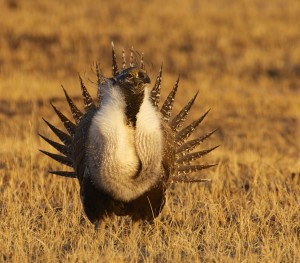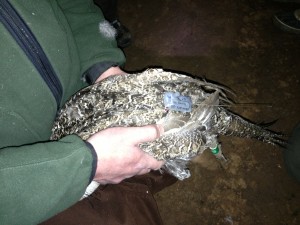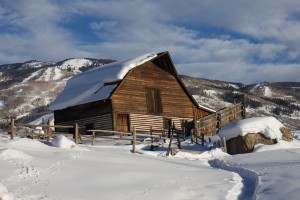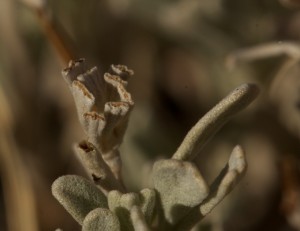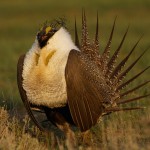 The paper on the sage-grouse mechanical sounds led by Rebecca Koch is now out in the journal The Auk: Ornithological Advances. Becca was one of our star undergrads, and the manuscript stemmed from her honors thesis in the lab. She is now a graduate student with Goeff Hill at Auburn University. The paper was published open access, meaning anyone can download the paper without needing a personal or institutional subscription to the journal. There’s also a nice editorial write-up by the journal.
The paper on the sage-grouse mechanical sounds led by Rebecca Koch is now out in the journal The Auk: Ornithological Advances. Becca was one of our star undergrads, and the manuscript stemmed from her honors thesis in the lab. She is now a graduate student with Goeff Hill at Auburn University. The paper was published open access, meaning anyone can download the paper without needing a personal or institutional subscription to the journal. There’s also a nice editorial write-up by the journal.
Tag Archives: publication
WSJ Article
 We’re back in California! I’ll have more on the end of the field season in another post. In the mean time, a quick mention that our research was mentioned in a recent Wall Street Journal article on ecotourism and sage-grouse. I’m not sure if this will be behind a paywall for some folks or not. I thought it was a pretty nice article. A couple of comments:
We’re back in California! I’ll have more on the end of the field season in another post. In the mean time, a quick mention that our research was mentioned in a recent Wall Street Journal article on ecotourism and sage-grouse. I’m not sure if this will be behind a paywall for some folks or not. I thought it was a pretty nice article. A couple of comments:
1) Much better than the last article in WSJ that really felt like a hit piece trivializing our research. Gail spent many hours over several months talking with a reporter, and the end product was extremely disappointing. We were hesitant to engage with them again, but I’m glad I did, since this article had a much different tone than the first.
2) The article makes it sound like we were the first to study strut rate in sage-grouse, which is definitely not true (and something I directly pointed out to the Jim). Strut rate is the most consistent correlate of mating success across studies and populations of sage-grouse, from Haven Wiley’s work in the Farson, WY population, to Mark Boyce’s eastern Wyoming studies, to the long term study of sage-grouse in the Mono Basin of California by Jack Bradbury and Robert Gibson. I would argue that our main contribution into this relationship is that we’ve gotten a bit more insight into the direction of causality. There’s always been the question– are the top males attracting females because they strut at a higher rate, or is the presence and proximity of interested females around the top males causing them to increase their display effort? With the fembot we could test all males on an even playing field by showing them a stimulus at a roughly equal range of distances and with similar female proceptivity, and measure their strut rate in a more controlled environment. Since maximum strut rate to the robot was correlated with mating success with real females, it suggests that females may be responding to the higher display rates. Top males are also adjusting more strongly to female cues (in the early experiment, we just measured the distance between the male and the robot), so the male response is also important. The good males do both.
2013 / 2014
2014 already has it’s talons in me, but I am pausing a moment to share some recollections of 2013 that was.
Last year I built upon my first full teaching gig in 2012. I taught both Animal Behavior during the summer and Evolution in the fall of 2013. The summer course was challenging because of the accelerated pace and because of some necessary travel, both scheduled and unscheduled, in the middle of the summer term. I was thankful to have an excellent co-instructor (Jamie Bunting), and I think we ended up putting together a nice class. The fall evolution course went well. Having a set of notes to work from made a huge difference in my sanity- I no longer felt quite as much of a ‘trying-to-keep-up-on-a-high-speed treadmill’ feeling. This let me put a lot more of my effort into improving the course. I was much happier with the exams in terms of length and clarity, and the homeworks and discussion were better integrated with the lecture material. To some extent this was behind the scenes stuff, and led to (I think) a comfortable class in which expectations for both me and the students were clearly presented. I look forward to working harder on lecture formats and classroom interaction next time I teach.
Research-wise, we got several projects out the door. These included our collaboration with Sergio Pellis on fighting dynamics in the grouse, an applied paper on the effects of radio collars on male sage-grouse in conjunction with Dan Gibson and colleagues at the University of Nevada Reno, a commentary on the utility of avian vocal studies that rely on calls instead of songs (with my former labmate Lauryn Benedict), and a review of male cooperation that I completed with other lab mates Sam Diaz-Muñoz, Eileen Lacey, and Emily DuVal. We got some of sage-grouse work out the door as well, an acoustics paper led by Rebecca Koch and our laterality analysis- these are in revision though.
Our new telemetry tags moved forward in 2013 as well. These tags are intended to give us an unprecedented window into the movement and activity of male grouse off the lek. We were able to do some proof of concept of them in the field at the end of the 2013 season. We followed that up with some testing of the accelerometer function by using some captive chickens in the Avian Sciences facility on campus. Now we’re just waiting for the final tags, and we’ll be ready to break a lot of new ground with our field studies in 2014.
2014 is already shaping up to be an exciting year. I got to attend the Winter Animal Behavior Conference a few weeks ago- this is a small, intimate meeting with just a few dozen top behavior folks. The conference strives for a really fun atmosphere. I presented some early analyses looking at differences in the distribution of male mating success on leks of different sizes. It feels great to finally be at the point where we can begin to leverage the multi-lek, multi-year nature of some of our data. I’m hoping that these sorts of analyses can complement our more focused studies and help round out the picture of how “negotiation” on the lek proceeds.
Along with making use of our older data, we’re also breaking new ground in the field. In addition to the aforementioned tags, we will conduct our first systematic plant sampling to learn more about variation in quality of the food the sage-grouse depend on during the winter.
This year should see some important and much needed modernization of our workflows as well. We’re finally upgrading our fleet of video cameras to move away from miniDV tapes and onto recording into digital media files on SD cards. This change will necessitate a host of other lab upgrades, including new computer workstations for viewing the video files (we are currently using a trio of refurbished laptops that are literally falling apart) and a robust server to distribute the video files. We may also finally move at least some of our data into a true database instead of simple spreadsheets. These transitions will require quite a bit of planning, but on balance should be big improvements.
Kiwi Commentary
It looks like the commentary that I wrote with Lauryn Benedict write is now online (it may require journal access- feel free to email me if you aren’t able to get it through your university’s network and would like a copy). Lauryn and I share a lot of the same pedigree: we were undergrads at Cornell, then jointly advised by Walt Koenig and Eileen Lacey at UC Berkeley for our PhDs . We even did our field research in the same place- the Hastings Natural History Reservation in Carmel Valley. Lauryn studied another one of those common but not terribly well known birds, the California Towhee.
It’s fun to get to write something up with a friend and colleague like this. Our manuscript puts some context around a paper on vocal behavior and duetting in a species of kiwi.
Sage-grouse Cort Paper Out!
Jessica Blickley’s Conservation Biology paper on the impact of chronic anthropogenic noise on sage-grouse took over 18 months to go through review. Thankfully our more recent paper proceeded much more quickly, in fact, it just came out. May I present: Experimental Chronic Noise Is Related to Elevated Fecal Corticosteroid Metabolites in Lekking Male Greater Sage-Grouse (Centrocercus urophasianus). This is in the journal PLoS One (PLoS = Public Library of Science, one of the first Open Access journals that charge a bit more for publishing but make the content freely available to everyone). The paper asks whether we can detect differences in traces of stress hormones in the poop of grouse that were on leks exposed to chronic noise versus control leks without the extra noise. The answer is yes, but like many things in science, the answer becomes a bit more complicated when you look at the details, or try to figure out what the results you find actually mean. There was a difference in the average level of corticosterone metabolites, but this wasn’t diagnostic. Additionally, it didn’t matter how close to the speakers the poop (and presumably the males) was, so the differences were shared across the entire lek. Still, further evidence that noise impacts are serious business for birds like sage-grouse, and are something management plans may want to take into account.
Jessica has another paper that just came out- this as the product of a seminar she took a couple of years ago. She and her colleagues put together a survey of job ads and questionnaires of people in charge of hiring conservation professionals- both to try to decode what skills ads are really asking for, and also to identify skills that graduate students might not get in the course of a “normal” PhD (whatever that is). It should be a really useful paper, and I’ll be sure to add it to one of the resources pages here next time I update those. So check out: Graduate Student’s Guide to Necessary Skills for Nonacademic Conservation Careers in Conservation Biology.
We’ve made some progress on several other fronts as well. We’ve gotten several other papers submitted, including a detailed look at fighting dynamics in male sage-grouse that I believe is our first paper making use of the high-speed video of male behavior. Another project we’ve gotten off of our desks is a characterization of the mechanical sounds in the sage-grouse, lead-authored by former undergrad and technician Becca Koch (now in a PhD program at Auburn). Gail and I also contributed to a paper on the negative effects of necklace-style transmitters in male-sage-grouse that included the acoustic analysis of one collared male with odd sounding displays. We have a few other manuscripts perched like baby birds at the nest hole, waiting to take that brave leap into the wide world of academic publishing. We should have at least one more paper make that leap before the end of the year. Big thanks to Gail for using much of her sabbatical to contend with some of this.
In other news, teaching is still the big focus, although I can’t believe how quickly it has gone. Only 4 more lectures in the quarter! I’m done with my other lectures for the time being (my City College of San Francisco seminar was on the previous Friday), but I’ve got several lectures, seminars, and meetings lined up for early in the new year including.

